
Union Station describes two distinct defunct train stations in Providence, Rhode Island.

The Hotel Kirkwood, also known as the Kirkwood Civic Center Hotel, is a historic building located in downtown Des Moines, Iowa, United States. The building was designed by the Chicago architectural firm of H.L. Stevens & Company and built in 1930. With its completion it became the largest hotel along Fourth Street between Walnut Street and Court Avenue, along Des Moines' "Hotel Row." It also marked the emergence of the skyscraper hotel in the downtown area. The new hotel replaced a previous Hotel Kirkwood that had been built on the same location in 1862. It was located near Union Station and the Rock Island Depot. Developers and owners of the 1930 Hotel Kirkwood were E.F. Tagney and S.F. McGinn. Art Deco details are found in the building's massing, the sleek exterior geometrical detailing, and treatment of the cornice. The 12-story brick structure rises to a height of 133 feet (41 m). It is listed on the National Register of Historic Places in 2003. The building has subsequently been converted into an apartment building called "The Kirkwood."

S. Stephen's Church is an historic Episcopal church located at 114 George Street in the College Hill neighborhood of Providence, Rhode Island. Located in the midst of the Brown University campus, it is an active parish in the Episcopal Diocese of Rhode Island, with a strong Anglo-Catholic identity.
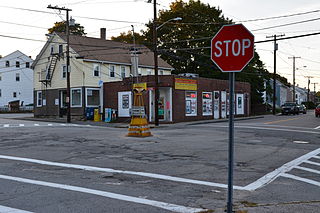
Albion is a village and historic district in Lincoln, Rhode Island, in the United States.
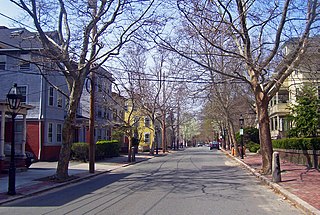
The College Hill Historic District is located on the East Side of Providence, Rhode Island, United States. It was designated a National Historic Landmark District on December 30, 1970. The College Hill local historic district, established in 1960, partially overlaps the national landmark district. Properties within the local historic district are regulated by the city's historic district zoning ordinance, and cannot be altered without approval from the Providence Historic District Commission.
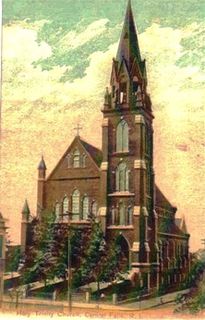
The Holy Trinity Church Complex is an historic church complex on 134 Fuller Avenue in Central Falls, Rhode Island.

All Saints Memorial Church is a historic Episcopal church at 674 Westminster Street in Providence, Rhode Island. The current church building, a large brownstone structure with a flat-topped tower, was designed by architect Edward Tuckerman Potter in a Gothic, Tudor Revival style, and built from 1869–1872. It is the largest Episcopal church building in the state, and its only known Potter-designed church. The accompanying (now-demolished) parish house is a Tudor Revival structure designed by Gorham Henshaw and built in 1909.

The Aylesworth Apartments are an historic apartment building at 188-194 Broad Street in Providence, Rhode Island. It is a 2-1/2 story structure, built in brick on the first floor, and with its upper floors finished in slate. It has a busy roofline, typical of the Queen Anne style popular when it was built in 1888-89. Its main entry is recessed under a large round archway which also has a small second-story porch under it. The building originally housed four apartments, but was altered in 1978 to house professional offices. It is the oldest known building built as an apartment house in the city.

The Woods–Gerry House is an historic house on 62 Prospect Street in Providence, Rhode Island. It is a large, three story brick structure, designed by Richard Upjohn and built in 1860 for Dr. and Mrs. Marshall Wood. It is the largest surviving 19th-century house in Providence, measuring 55 feet (17 m) in width and 75 feet (23 m) in depth. It features restrained Italianate styling, most evident in its porch and porte-cochere, and in its roofline. The building currently houses the Admissions office for the Rhode Island School of Design.

The Brown & Sharpe Manufacturing Company Complex is a historic factory complex in Providence, Rhode Island along the Woonasquatucket River. The 25-acre (10 ha) complex occupies most of a large city block bounded on the south by Promenade Street, the west by Bath and Calverly Streets, the north by West Park Street, and the east by Interstate 95. The complex was the longtime home of Brown & Sharpe Manufacturing Company, a manufacturer of precision equipment founded in 1833. The company was originally located in downtown Providence, but moved to this site in 1872, where it remained until 1964, when it moved to North Kingstown. Fourteen of the company's buildings survive.

The Calvary Baptist Church is an historic church at 747 Broad Street in Providence, Rhode Island.

The Covell Street School is an historic school building at 231 Amherst Street in Providence, Rhode Island. It is a two-story wood frame structure built in a typically elaborate Queen Anne style. Although it is basically rectangular in plan, its roofline and exterior are busy, with a complicated group of cross gables, hip-roof sections, with projecting and recessed sections. A three-story square tower rises from the center of the main facade. Built in 1885 and opened in 1886, it is one of Providence's last surviving 19th-century neighborhood school buildings. It was designed by the local firm of William R. Walker & Son, designers of many Rhode Island civic buildings. The builders were John L. Sprague & Company.

The Thomas F. Hoppin House is a historic house at 383 Benefit Street in the College Hill neighborhood of Providence, Rhode Island. The house was built c. 1853 to a design by Alpheus C. Morse, and is an elaborate local example of an Italianate palazzo-style residence. The Hoppins were well known for the social gatherings, and their house became known as the "house of a thousand candles".
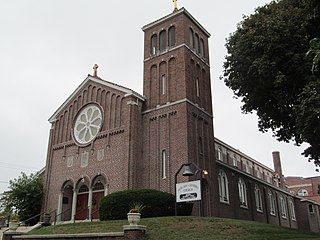
Our Lady of Lourdes Church Complex is an historic Roman Catholic church complex at 901-903 Atwells Avenue in Providence, Rhode Island within the Diocese of Providence.
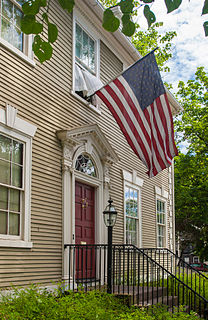
The Nathaniel Pearce House is an historic house at 305 Brook Street in Providence, Rhode Island. This Early Republican house is an "archetype of domestic design of its period". It was built in 1801 at 41 George Street on Brown's Main Green facing University Hall, where it enjoyed a view of Narragansett Bay. Nathaniel Pearce, a ship-master and ship-owner, purchased it circa 1780, doubled its size with a central hallway and new ornamental entrance and re-oriented to George Street in 1800. By 1888 it was owned by the Goddard family, who sold the George Street land to Brown University. Conditions of the sale required the house be either demolished or moved. John J. DeWolf bought the house and moved it to Brook Street in that year. In 1915, his nephew Halsey DeWolf, MD inherited the house and commissioned an expansion and colonial revival enhancements by his wife's cousin, architect Wallis E. Howe of Clarke & Howe. Landscape architects Searle & Searle refurbished the rear garden in the mid 1990s.

Temple Beth-El, known locally as the Broad Street Synagogue, is a historic Jewish synagogue at 688 Broad Street in Providence, Rhode Island.

The Wayland Historic District is a predominantly residential historic district on the east side of Providence, Rhode Island. It is a large area, covering about 122 acres (49 ha), bounded roughly on the north by Everett and Laurel Avenues, on the east by Blackstone Boulevard and Butler Avenue, on the west by Arlington Avenue, and on the south by Angell and South Angell Streets. This area, which was in the 19th century part of the Moses Brown farm, was platted for development in 1891, with most of the construction taking place in the early decades of the 20th century. Most of the residential properties in the district are single-family houses, typically built in revival styles popular at the time. They are set on similarly-sized lots with fairly uniform setbacks, and were typically built without garages. There are a number of two-family houses, and a small number of apartment buildings, most of which are found on the arterial roads of the area. There are several religious buildings, including several churches; the most architecturally distinctive religious building is the Jewish Temple Beth El, built 1951-54.
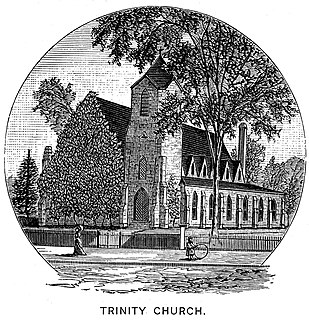
Trinity Episcopal Church was a historic church located at 48 Main Street in Pawtucket, Rhode Island. Built by the Episcopalians, the building was sold to the Catholics in 1977 and became the St. George Maronite Catholic Church within the Diocese of Providence. The church burned down in 2005, and was not rebuilt.

The Palmer Park Boulevard Apartments District is a collection of three apartment buildings located at 1981, 2003 and 2025 West McNichols Road in Highland Park, Michigan. The district was listed on the National Register of Historic Places in 1992.

Rosedale Apartments are a historic apartment house at 1180 Narragansett Boulevard in Cranston, Rhode Island. This U-shaped apartment block stands overlooking Narragansett Bay, with three stories facing the street and four toward the bay. The Art Moderne structure was designed by Herbert R. Hunt and built in 1939-40. It is a rare statewide example of a large-scale building in this style, and was one of only a few built in Cranston before the Second World War.


























